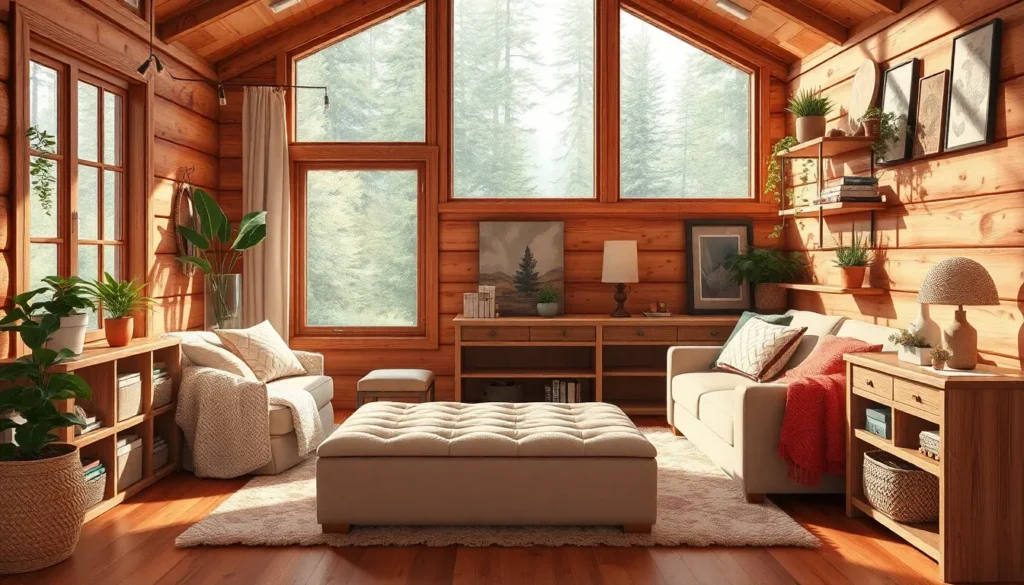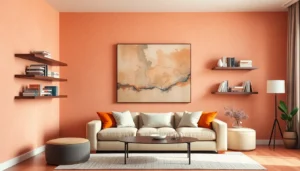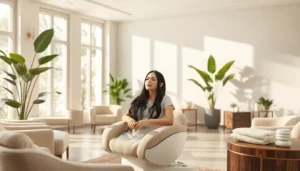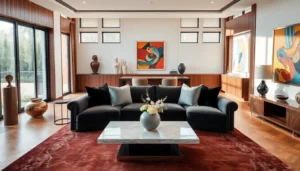Imagine stepping into a cozy cabin where every nook and cranny whispers comfort and charm. Small spaces can feel daunting, but with the right interior design ideas, they transform into havens of style and warmth. Cabin life isn’t just about rustic vibes; it’s about making the most of every square foot while keeping it fun and functional.
Table of Contents
ToggleSmall Cabin Interior Design Ideas
Cozy furnishings enhance the warmth of any small cabin. Use a mix of soft textiles like flannel and wool for cushions and throws. A sectional sofa can maximize seating while maintaining an open feel.
Incorporate multifunctional furniture. An ottoman with storage or a coffee table that transforms into a dining table saves space and adds versatility. Choose collapsible chairs to provide extra seating when needed.
Color choices significantly impact the ambiance. Opt for light colors to make spaces feel larger and more airy. Neutral tones paired with natural wood accents create a calming environment. Adding a pop of color through décor or artwork brings personality to the interior.
Lighting plays a pivotal role in cozy cabin design. Incorporate layered lighting; a combination of overhead and task lighting ensures a welcoming atmosphere. Statement pendant lights or decorative wall sconces offer both style and functionality.
Indoor plants enhance the connection to nature. Use small potted plants or terrariums to bring life to shelves and tabletops. A vertical garden can effectively utilize wall space while providing a refreshing aesthetic.
Artisan accents add unique character. Incorporate handmade items like pottery or woodcrafts to reflect the cabin’s rustic charm. A gallery wall featuring local landscapes or personal photography creates a narrative in the space.
Lastly, maximize natural light. Keep window treatments minimal to allow sunlight to flood in. Consider installing mirrors to reflect light and make the area feel more expansive.
Maximizing Space
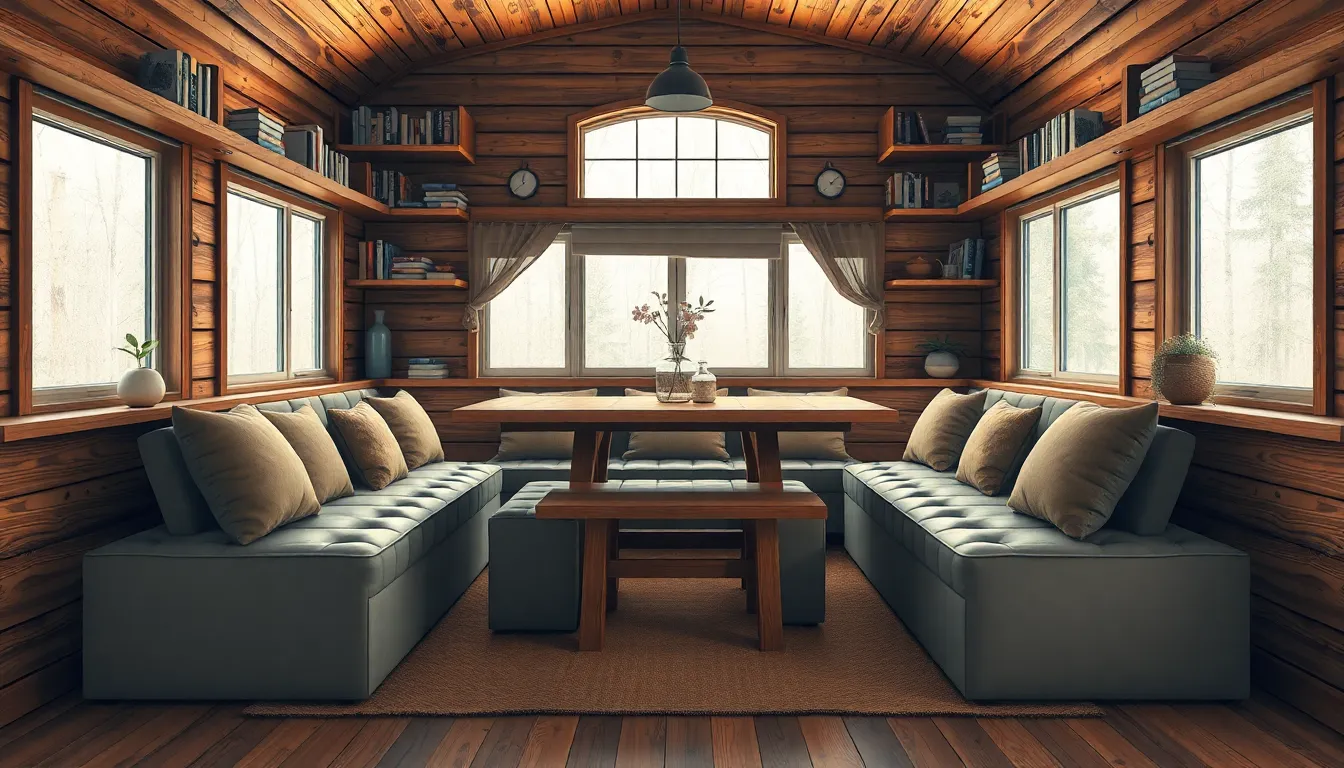
Maximizing space in small cabin interiors enhances both functionality and aesthetics. Effective design strategies contribute significantly to this goal.
Multi-Functional Furniture
Multi-functional furniture serves as a cornerstone in compact cabin living. Beds with built-in storage offer both a sleeping area and a place for belongings. Ottomans can provide extra seating while doubling as storage units. Folding tables allow for dining or workspaces to be used only when needed. Selecting pieces that adapt to various uses maximizes available space without sacrificing style.
Open Floor Plans
Open floor plans create a sense of airflow and spaciousness in small cabins. By eliminating unnecessary walls, design facilitates movement and interaction among distinct areas. Defined zones can still exist through furniture arrangement, area rugs, or lighting variations. Implementing an open layout fosters a welcoming atmosphere, making it easier to entertain or enjoy solitude. Maximizing vertical space with shelving or artwork also enhances the overall design without overcrowding.
Color Schemes and Materials
Color schemes and materials significantly impact small cabin interiors, enhancing comfort and style. Selecting the right elements creates a harmonious and inviting space.
Natural Wood Accents
Natural wood accents transform small cabins, adding warmth and texture to interiors. Exposed beams highlight rustic charm while giving a sense of height. Reclaimed wood furniture introduces character, often telling a story through its wear. Using wood paneling can create a cozy ambiance, providing visual interest. Complement these features with natural finishes to enhance authenticity, such as matte or satin. Choosing lighter woods, like pine or ash, keeps the cabin feeling open and bright. Incorporating wooden decor items further ties in the theme, with elements like shelves or wall art enhancing the aesthetic.
Light and Airy Palettes
Light and airy palettes create a refreshing atmosphere in small cabins, making spaces feel larger and more inviting. Soft shades such as whites, creams, and pastels reflect light effectively. Such colors promote a sense of openness and tranquility, ideal for relaxation. Accenting with vibrant hues injects personality into the design without overwhelming the space. Choosing pastel furniture or accessories harmonizes with lighter walls, ensuring a cohesive look. Incorporating natural textiles, like linen or cotton, further enhances the airy feel. Layering these colors fosters a serene environment, encouraging a serene escape into nature.
Cozy Decor Elements
Incorporating cozy decor elements transforms small cabins into inviting retreats. Specific features enhance comfort and aesthetics.
Warm Textiles and Rugs
Soft textiles play a crucial role in creating warmth. Plush blankets or throws add layers to seating areas. Area rugs anchor spaces, define zones, and bring texture. Opting for natural materials like wool and cotton increases comfort and supports a cozy ambiance. Patterns and colors should complement the overall design theme, adding visual interest without overwhelming the limited space.
Personal Touches and Art
Unique art pieces and personal touches create a cohesive and inviting environment. Family photos in rustic frames tell a story and establish a personal connection. Handcrafted items, such as pottery or wall hangings, contribute character to the decor. Selecting artwork that reflects the cabin’s surroundings enhances the natural theme and fosters an emotional bond with the space. Personalized decor infuses warmth and individuality, making the cabin truly feel like home.
Outdoor-Indoor Connection
Connecting indoor and outdoor spaces enhances the feeling of spaciousness in a small cabin. Strategic design elements foster an inviting environment that bridges nature and interior comfort.
Large Windows and Doors
Large windows create a seamless connection between the indoors and outdoors. Expansive glass doors allow natural light to flood the interior, making spaces feel more open. Views of the surrounding landscape draw the eye outside, promoting a sense of tranquility. Utilizing sliding or folding glass doors encourages easy access to porches or decks. Natural light highlights design features and soft textiles, reinforcing a warm atmosphere. Frameless glass options enhance the effect, providing unobstructed views and allowing for fresh air circulation.
Outdoor Living Spaces
Creating outdoor living spaces extends the cabin’s footprint. Decks and patios serve as additional areas for relaxation or entertaining. Incorporating comfortable seating with outdoor cushions invites gatherings under the stars. Fire pits encourage cozy evenings and foster a connection to nature. Elevating the landscaping with native plants enhances visual appeal and offers privacy. Outdoor dining spaces promote al fresco meals, merging dining experiences with fresh air. Emphasizing durability and weather resistance in furniture ensures longevity, maintaining the cozy cabin vibe.
Transforming a small cabin into a cozy retreat is all about thoughtful design choices. By combining functionality with style, anyone can create a space that feels both inviting and practical. Incorporating natural materials and light color palettes enhances the cabin’s charm while promoting a sense of openness.
Emphasizing personal touches and unique decor elements adds character and warmth. The seamless connection between indoor and outdoor spaces further elevates the experience, making the cabin a true sanctuary. With these design ideas in mind, small cabins can become the perfect haven for relaxation and enjoyment.
